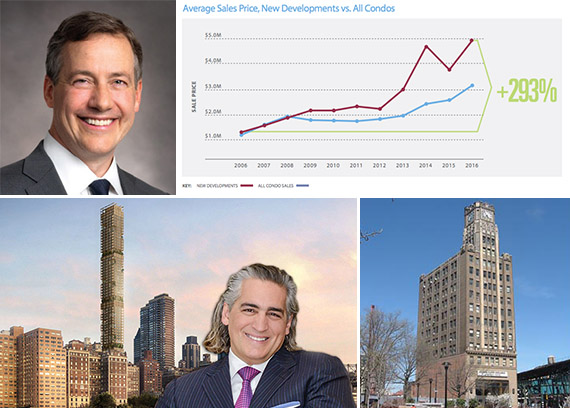From 2013 to 2015 , this is what qualified for “normal”: a record-breaking sale was immediately bested by another, asking prices were determined by comps from a wildly unrealistic peer group, and the target buyer was a 1% captain of the universe. So what does it look like when “normal” becomes…well, normal again?
CityRealty released its year-end residential market report last week, and when Reuters, Forbes and other outlets picked it up, they highlighted this stat: In 2016, the average price of a Manhattan apartment eclipsed $2 million for the first time ever. But the forces that shaped that number demand a closer examination.
Total closed new development sales will hover just under $9 billion this year, up nearly 60 percent from $5.4 billion in 2015, according to CityRealty. But these closings reflect contracts that were signed when the market was in a frenzy between 2012 and 2014. Inventory of top-shelf product was limited, and demand for it was at an all-time high.
We’re in a very different position now. Demand for ultra-luxury pads is down significantly, and developers are bringing fewer 432 Parks [TRDataCustom] and One57s to market: The target offering price for new condos approved for sale by August 2016 was down nearly 35 percent year-over-year, according to a TRD analysis. Many developers are also sucking it up and lowering projected sellouts on existing projects.
Whenever closings at 220 Central Park South and 520 Park Avenue get going — and if Extell’s Central Park Tower gets built — expect the numbers in those years to get a boost. In general, however, it appears we’re in for a more modest 2017, with developers likely targeting lower-priced segments of the market.
Leonard Steinberg, who seems to be able to whip out quotes on demand from that magnificent silver briefcase of his, described the new reality as one of “rational exuberance.”
CoStar bares its teeth — again
In March, CoStar Group, the 800-pound, $6 billion-plus gorilla of commercial real estate technology, reached a settlement with RealMassive, a startup real estate data marketplace. CoStar had sued the smaller firm alleging it deliberately used proprietary images from CoStar’s database, and described the startup as one “powered by content that is stolen from those who created it through hard work and investment.”
Rather than duke it out with CoStar in court, RealMassive said it agreed to pay a settlement of $1 million to the real estate tech giant. CoStar CEO Andy Florance, describing the settlement in his company’s first-quarter earnings in April, said CoStar was “all for fair competition, but theft is not competition.”
Now, CoStar is waging war against Xceligent, arguably its biggest rival. In a multimillion-dollar lawsuit, it alleged Xceligent had engaged in “copyright infringement on an industrial scale,” saying that its army of researchers systematically steal CoStar’s data and images. Xceligent CEO Doug Curry blasted the suit, saying it “fits with a pattern of action by CoStar of filing lawsuits against its competitors to protect its dominant market position.” The firm noted that CoStar’s suit comes just as Xceligent is gearing up to launch in New York, its rival’s most important market . Sources told TRD‘s Konrad Putzier in August that Xceligent is the only company seriously attempting to market a product similar to CoStar.
Queens Clock Tower project now under Durst’s watch
The Durst Organization is the new owner of Queens Plaza Park, the site of the landmarked Clock Tower that allows for a project of about 1 million square feet. The sellers, Hakim Organization and Property Markets Group, were planning an 800-unit project (⅔ rental, ⅓ condo), but were struggling to land a construction loan. Durst, instead, intends to build a 1,000-unit all-rental project with the help of 421a if the abatement is reinstated.
“They are a good developer that can take better advantage of the site,” Hakim said to TRD of Durst. “It was too big for us.” PMG principal Kevin Maloney told the Times that he and Hakim “didn’t have the horsepower to get it done.”
Maloney has been one of the most outspoken players about the luxury market’s weakness. Explaining his decision to delay the sales launch at 111 West 57th Street, he told Bloomberg: “If you have a market where you think marketing would be ineffective for now, why would you launch and spend the money? Wait.”
For cash-rich Durst, however, this is the time to strike. It recently took control of Bruce Eichner’s 1800 Park Avenue in a short sale.
“Acquiring distressed sites allows us to build rentals and make the long-term investments that have served us well for more than 100 years,” Durst told the Times.
Beninati bows out at 3 Sutton
For Joe Beninati, 3 Sutton Place was his chance to transform from an also-ran in Connecticut into a major player in Manhattan.
“There are guys who go 20 years and have major-league careers and never get up to bat in the World Series,” he told Crain’s recently. “It just doesn’t work out.”
But Beninati’s dream of building a 950-foot-tall luxury condo in the big city came to an ugly end last week. After defaulting on his high-interest loan from N. Richard Kalikow’s Gamma Real Estate, he lost his battle to stave off a foreclosure auction. Gamma won the auction last week and can now move ahead with the project itself, bring in a joint venture partner or try to sell the site.
All of the options look tricky: Gamma’s overall investment in the site, counting the defaulted-upon loan and the auction price, is about $670 a foot, according to Crain’s. Finding a buyer at a price that would recoup that investment could be challenging, and moving ahead with the development at an uncertain time for the condo market even more so.
(Paydirt is a weekly column that riffs on the biggest NYC real estate news of the moment, providing analysis and historical context on the deals and players that make this town tick. Read more from Paydirt here.)
